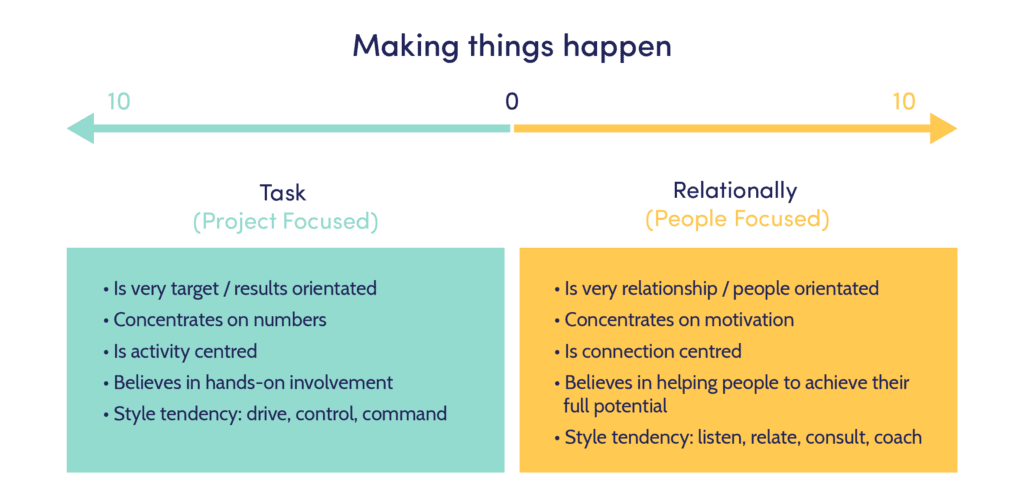Much has been written about Task vs. Relationship Leadership. Of course, there are benefits to both leadership styles, and it is generally understood that leaders need to utilise both. Yet, as a coach working with senior executives, I see that many leaders remain too focused on the task side of leadership. Nothing has made this more apparent than the coronavirus pandemic (which I will discuss in a minute).
The Task vs. Relationship Leadership spectrum is an important lens for mid- and senior-level leaders to apply when assessing their effectiveness. However, there are three reasons why this tool may be underutilised:
- A general lack of awareness among leaders of this management concept. Some may understand it intuitively but may not have clarity around how it applies to them or how they can leverage it to become a better leader.
- Too many leaders remain habitually focused on only the task side of the spectrum. This gives them a huge amount of strength—because they are results-focused and driven. They make things happen through action (but it ignores the strengths that the relationship side offers).
- Many senior leaders still believe that in order to make things happen, the task-oriented style is the correct focus. Why might this be?
- During junior and middle leadership, they may have been rewarded and promoted because of their ability (and sometimes their preference) to primarily work on the task side.
- Their family backgrounds instilled task-focused values and behaviours (sometimes at the expense of their emotional intelligence). Given this, part of the journey of any senior leader is an excavation of the past, never more so for those who don’t understand why it can be so difficult to work relationally.
- They believe that ‘If “I” am not doing, “I” am not creating value’. For many, it’s counterintuitive for them to ‘let go’ of the task, because they believe that their significance and accountability equals ‘I’m doing’.
Note: Executive coaching offers tools and techniques that enable leaders to work more relationally
The pandemic has enabled some leaders to shift more attention to the relational side of the spectrum because they are forced to confront their own and others’ emotions and psychology around the crisis. It’s simply unavoidable. Unprecedented uncertainty, and constantly changing conditions, means the ability to pivot and flex at pace across the spectrum has become paramount to effectively leading people.
But this shift is not easy for everyone. One leader I coach took on a new GM role a few months prior to the pandemic. He’d been given the role because he was a results-driven problem-solver with a track record for driving change. In spite of this, he still found himself struggling to get his people to understand why they should focus their efforts on improving the business. Why? Because he had not invested the time to understand his people’s motivators and blockers.
As the coronavirus struck, his task-focused leadership enabled him to refocus the business from bricks-and-mortar to online offerings for customers. Despite his ability to proffer clear steps and solutions to his team, some of his people were stuck and unable to move—frozen by fear and anxiety. One senior team member, overwhelmed by her fears, literally did nothing for weeks with any of their agreed actions.
Because this leader was primarily task focused, he was missing the opportunity to facilitate conversations that would enable his staff to articulate and process their emotions and become ‘unstuck’. In order to achieve his desired outcomes, he needed to focus on ‘the people’, not ‘the project’. In short, he needed to create the time and space for his people to adjust psychologically to new circumstances.
His story illustrates the fact that—pandemic or not—many senior leaders remain over-focused on the task-oriented approach to leading people.
Naturally, there are situations that call for leaders to be 100% focused on the task side of the equation—especially in times of acute crisis. If four of your factories go down in southern China, you need go into ‘command and control’ mode. You recalibrate product orders, redirect people and logistics and reroute supply chains—ideally, within 24 hours. However, in times of chronic crisis, as we are experiencing now, we need to see an evolution of leadership that moves more towards working relationally. The paradox is when leaders spend more time on the relationship side of the spectrum, output on the ‘task’ side increases.
Use the graphic below to assess where you spend most of your time in any given week. Now think about where you spend your time month-to-month. Senior leaders ideally spend 60-80% of their time on the Relationship side of the spectrum.
Ask yourself three questions:
- ‘Where am I spending my time?’
- ‘What is my average weekly or monthly ratio?’
- ‘What do I need to do differently to improve as a leader?’

If you’d like to learn how executive coaching can increase your leadership effectiveness, please contact us for a complimentary session
